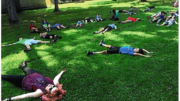Butler, PA – The first exhibit of 2018 at the Mary Hulton Phillips Gallery at Butler County Community College showcases the creations of a BC3 alumna who while thinking outside the box often confines her pieces within one.
“A lot of people say, ‘I would like to look inside your mind,’” said Carol Griffiths, whose “The Right to Peaceful Assemblage” will be displayed from Wednesday to Feb. 28.
The Erie resident scours the Great Lake’s rocky shore roughly three times a week 10 months a year, gathering the driftwood and rusty metal the tide washes nearly to her front door and that through her imagination and insight receive a second life.
“I want to see if I can give it another purpose,” said Griffiths, a 1976 graduate of Ford City High School who in 2001 earned an associate degree in general studies from BC3 before attaining a bachelor’s degree from Geneva College, Beaver Falls. “I don’t want to give up on it because it still has beauty to contribute to the world.”
Griffiths’ is assemblage art, said David Ludwick, curator of the Mary Hulton Phillips Gallery, a BC3 fine arts instructor and director of the Hoyt Institute of Fine Arts in New Castle from 1980-87. The genre, he said, is an inverted form of sculpture, in which material is added rather than subtracted. It is, according to the Lazarus Corporation – a coalition of independent artists, writers and musicians working in related themes, “basically the three-dimensional cousin of collage.”
Her signature, Ludwick said, reflects Griffiths’ use of numerous and different elements.
“So much of her work is from materials or objects you would find around the lake,” Ludwick said. “She uses a lot of materials that have been exposed to the weather up there. The wood tends to oftentimes have a weathered look or it takes on that grayish color of driftwood.”
Lakefront discoveries hold stories
Griffiths, who has created up to 400 such pieces, didn’t know such a genre of art existed until after she had moved to Erie in May 2009, to within 100 yards of the shore, and began to shape such works.
“I started walking on the lakeshore picking up objects, and just wanted to do something with them,” she said. “Wanting to show them to people. And I started doing assemblage art before I even knew there was such a thing.”
Assemblage art is broader than paint and drawing, mediums she studied with Ludwick, Griffiths said.
“There is more you can say with assemblage than just with paint because of the different components that you can put together,” Griffiths said. “Each object that I put into an assemblage has a story itself. It represents something. People are used to looking at an object in a certain way. It has a certain use. But when you put it into a piece of art it breaks that object out of that category that you have in your mind. This is what this object was for. It could also be for other things.”
Griffiths’ works also include items salvaged from thrift and other stores.
A member of the Northwest Pennsylvania Artists Association, Griffiths was awarded “Best of Sculpture” at the Ruth Jageman Panorama Juried Art Exhibition during the Erie Summer Festival of the Arts for her assemblage, “Elephant” – constructed with aluminum and a discarded faucet. Her work is represented in several Erie galleries, including a commissioned installation at The Brewerie at Union Station. Some of her sold work has been sent to Portland, Denver, Pittsburgh, Boston and Tampa.
“Carol’s past art expression has been with pencil, ink, acrylic paint and mixed media, which led her to the free-thinking processes of constructing assemblage art,” Ludwick said. “She now varies the look of her work by a combination of these mediums, often adding wood stains and spray paint as well.”
Storms replenish art supplies
Griffiths, who said the best time to walk the shore is at low tide, and after a storm – “because the lake brings new things in when it is rough during a storm. So that is always a good time to go’’ – brings her discoveries home, where she uses a bevy of drills and power saws and scroll saws and circular saws to reshape and repurpose her finds.
“What I really like to use are materials that were once used by humans, so they have been touched by other humans and nature,” Griffiths said. “So it is a combination of how it has been used and weathered in the past and what story might it have to tell if we had a chance to talk to it.
“They had a former life, most of them,” Griffiths said. “If we can call it that. A purpose, I guess. Other than what I am doing with it.”
She then uses nails or screws, wood glue or flooring adhesive, to secure her work within a box. Or vice-versa.
“Sometimes I start from the outside and work in,” Griffiths said. “Sometimes I work from the inside and build the frame around it.”
The most difficult thing to know about a piece of art,” she said, “is when it is done. Is it OK as-is? Does it need something more? Did I overdo it? You just need to know when to quit. I think I am learning that, as far as not to quit too soon, but does it need something more?”
Nearly three dozen works to be on display
Thirty-four of her pieces will be on exhibit, including those named “Tall Ships,” “Winter on the Bay,” “Harbor,” “Sun,” “Moon” and “Asteroid.”
Griffiths’ exhibit will be followed by that of Eileen (Tyke) Vaughn’s traditional oil paintings in March, and BC3’s second student art showcase since 2011 in April.
A reception for Griffiths will be held from 6 p.m. to 9 p.m. Jan 19 in concert with a performance by The Tamburitzans. The longest-running multicultural song and dance company in the United States will perform at 8 p.m. Jan. 19 in nearby Succop Theater.
The Mary Hulton Phillips Gallery is open 9 a.m. to 4 p.m. Monday through Friday.






Be the first to comment on "Works of Great Lake Artist, Tied to Tide, Coming to BC3 Gallery"